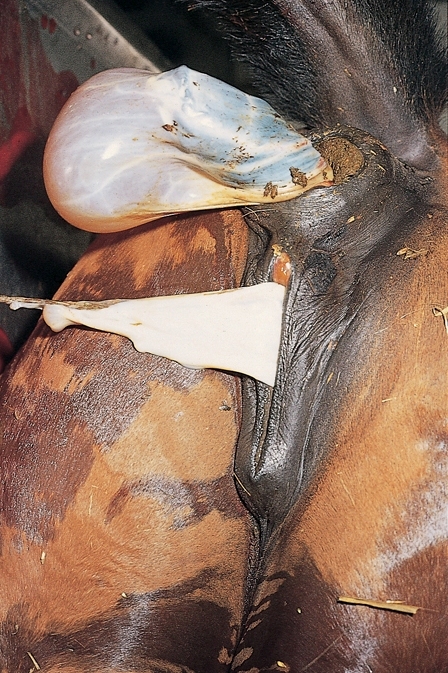Difference between revisions of "Equine Reproduction and Stud Medicine Q&A 04"
Jump to navigation
Jump to search
| Line 17: | Line 17: | ||
|a1=The so-called foot-nape posture. | |a1=The so-called foot-nape posture. | ||
In this case, one or even both feet have already penetrated the dorsal vaginal roof as well as the rectum, forming a rectovaginal fistula. The long limbs and relatively slender head of the foal make this posture feasible in the mare. The foot of the foal is directed dorsally by the transverse fold between vagina and vestibule. After a long period of severe non-productive straining, a foot-nape posture may lead to such a rectovaginal fistula or eventually a third degree perineal laceration. | In this case, one or even both feet have already penetrated the dorsal vaginal roof as well as the rectum, forming a rectovaginal fistula. The long limbs and relatively slender head of the foal make this posture feasible in the mare. The foot of the foal is directed dorsally by the transverse fold between vagina and vestibule. After a long period of severe non-productive straining, a foot-nape posture may lead to such a rectovaginal fistula or eventually a third degree perineal laceration. | ||
| − | |l1= | + | |l1=Recto-Vaginal Fistulae |
|q2= How would you manage this case? | |q2= How would you manage this case? | ||
|a2= If possible, it is important to keep the animal on her feet, and quiet walking may decrease straining efforts. Reposition is first attempted after epidural anaesthesia. The foal is forcefully repelled and if possible the foreleg(s) are lifted and placed underneath the head. If this is not successful and the foal is still alive, incision of the perineum may be necessary before extraction of the fetus. If the fetus is dead a quick partial fetotomy is indicated. The feet can be sectioned in the radius after which a careful extraction will be possible. The traumatised tissue should be checked for bleeding, and devitalised tissue removed. Final repair of the perineal laceration may be best delayed until weaning of the foal, i.e. at least a few months after parturition. | |a2= If possible, it is important to keep the animal on her feet, and quiet walking may decrease straining efforts. Reposition is first attempted after epidural anaesthesia. The foal is forcefully repelled and if possible the foreleg(s) are lifted and placed underneath the head. If this is not successful and the foal is still alive, incision of the perineum may be necessary before extraction of the fetus. If the fetus is dead a quick partial fetotomy is indicated. The feet can be sectioned in the radius after which a careful extraction will be possible. The traumatised tissue should be checked for bleeding, and devitalised tissue removed. Final repair of the perineal laceration may be best delayed until weaning of the foal, i.e. at least a few months after parturition. | ||
| − | |l2= | + | |l2=Recto-Vaginal Fistulae#Treatment |
|q3= What is your prognosis? | |q3= What is your prognosis? | ||
|a3= Although the function of the anal sphincter is not always completely restored, the prognosis for surgical restoration of the rectal and vaginal wall a few months after birth is good. | |a3= Although the function of the anal sphincter is not always completely restored, the prognosis for surgical restoration of the rectal and vaginal wall a few months after birth is good. | ||
| − | |l3= | + | |l3=Recto-Vaginal Fistulae#Prognosis |
</FlashCard> | </FlashCard> | ||
Latest revision as of 17:30, 2 August 2011
| This question was provided by Manson Publishing as part of the OVAL Project. See more Equine Reproduction and Stud Medicine questions |
You receive an urgent call to attend a primiparous mare and are presented with this situation:
| Question | Answer | Article | |
| What is this serious condition? | The so-called foot-nape posture.
In this case, one or even both feet have already penetrated the dorsal vaginal roof as well as the rectum, forming a rectovaginal fistula. The long limbs and relatively slender head of the foal make this posture feasible in the mare. The foot of the foal is directed dorsally by the transverse fold between vagina and vestibule. After a long period of severe non-productive straining, a foot-nape posture may lead to such a rectovaginal fistula or eventually a third degree perineal laceration. |
Link to Article | |
| How would you manage this case? | If possible, it is important to keep the animal on her feet, and quiet walking may decrease straining efforts. Reposition is first attempted after epidural anaesthesia. The foal is forcefully repelled and if possible the foreleg(s) are lifted and placed underneath the head. If this is not successful and the foal is still alive, incision of the perineum may be necessary before extraction of the fetus. If the fetus is dead a quick partial fetotomy is indicated. The feet can be sectioned in the radius after which a careful extraction will be possible. The traumatised tissue should be checked for bleeding, and devitalised tissue removed. Final repair of the perineal laceration may be best delayed until weaning of the foal, i.e. at least a few months after parturition.
|
Link to Article | |
| What is your prognosis? | Although the function of the anal sphincter is not always completely restored, the prognosis for surgical restoration of the rectal and vaginal wall a few months after birth is good.
|
Link to Article | |
